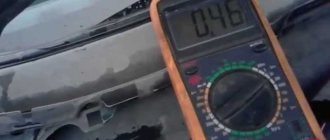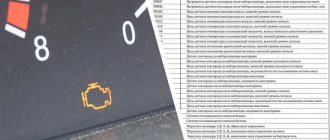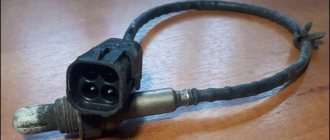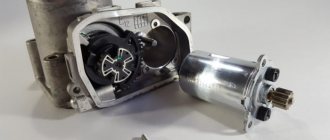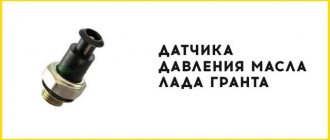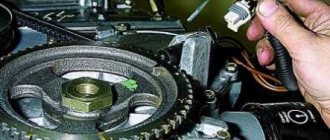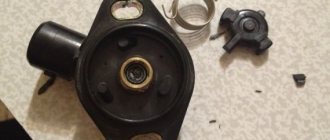What does P0134 mean?
The oxygen sensor monitors the oxygen content in the vehicle's exhaust gases. It sends a signal to the transmission control module (PCM), which in turn uses the information received to regulate the ratio of fuel and air mixture supplied to the engine cylinders.
When there is insufficient oxygen in the exhaust gases, the vehicle's PCM reduces the amount of fuel used by the engine. This is important because if there is not enough oxygen in the exhaust gases, fuel consumption increases, as well as the amount of harmful substances emitted from the vehicle's exhaust gases.
When there is insufficient fuel, the vehicle's PCM increases the amount of fuel used by the engine. This is also quite important because if there is not enough fuel, hydrocarbons and nitrogen oxides will be released into the atmosphere.
Why is a lambda probe needed in a car, location
A lambda probe is necessary to measure the oxygen content coefficient in a combustible mixture. It is always installed in the area of the exhaust pipe before the catalyst and measures the volume of unburned oxygen in the combustion products. This information will allow the ECU to prepare the optimal mixture.
A mixture containing 14.7 parts air and one part fuel burns most efficiently. These are optimal indicators; if oxygen is present in large quantities, then the mixture is lean; if there is less air, then it is rich.
Combustion of a rich mixture is less efficient - a decrease in power and increased fuel consumption can be observed.
Since the engines in cars operate in completely different modes, the optimal ratio of air and fuel may not be observed. Oxygen sensors are used to control the quality of the mixture in power systems.
Based on the signals from the lambda, the ECU can assess the quality of the mixture. If indicators are found that do not meet the standards, the mixture is adjusted.
Operating principle of the oxygen sensor
The principle of operation of the oxygen sensor is quite simple. The lambda probe must compare the readings with some ideal results in order to understand how the percentage of oxygen in the mixture changes, so measurements are taken in two places - atmospheric air and combustion products .
This approach allows the sensor to feel the difference if the fuel mixture ratio changes.
The ECU must receive an electrical impulse from the lambda probe. To do this, the sensor must be able to convert measurements into electrical signals. For measurements, special electrodes are used that can react with oxygen.
Lambda uses the principle of galvanic cells - changing the conditions of chemical reactions leads to a change in the voltage between the two electrodes. When the mixture is rich and the oxygen content is below the lower threshold, then the voltage rises. If the mixture is lean, the voltage will drop.
Next, the impulse that occurs at the stage of chemical reactions is sent to the ECU, where the parameters are compared with the fuel maps stored in the memory. As a result, the operation of the power system is adjusted.
The oxygen sensor operates on chemical reactions, but its design is relatively simple. The main element is a special tip made of ceramic materials. Zirconium dioxide and, less commonly, titanium dioxide are used as raw materials.
The tip is coated with platinum - it is this layer that reacts with oxygen. One side of this tip is in contact with the exhaust gases, the other side with the air in the atmosphere.
This is interesting: How to make a simple device for checking spark plugs
The lambda probe electrodes have one feature. So that the reaction is more efficient and the indicators are accurate, measurements of the oxygen content in the exhaust are carried out under certain temperatures.
In order for the tip to reach the performance characteristics and the required electrical conductivity, the temperature of the environment should be 300-400 degrees.
To ensure the required temperature regime, the lambda probe was initially installed in close proximity to the exhaust manifold. This ensured the desired temperature after warming up the internal combustion engine. The sensor did not start working immediately. Before the lambda warmed up enough and began to produce accurate parameters, the ECU used signals from other sensors. The optimal mixture was not prepared during the heating process.
Some oxygen sensor models are equipped with electric heaters. Thanks to them, the lambda can quickly reach operating temperature conditions. Heating uses energy from the vehicle's on-board network.
What does the error indicate?
The error with this code is quite common and is not considered particularly complex. Such a notification tells the driver that the information coming from the first oxygen sensor is incorrect or is issued with violations. You can diagnose the supply of incorrect information from the sensor to the ECU as follows:
- When the signal from the oxygen sensor is low, the information is transferred to the ECU memory and recorded;
- The data is sent to the ECU and recorded if there are no changes in the information from the oxygen sensor;
- The vehicle's check light comes on when the violation is permanent.
What are the symptoms of code P0134?
In some cases, there may be no symptoms other than a stored DTC and CHECK ENGINE light. On the other hand, some consequences may be so severe in other cases that the vehicle becomes undriveable.
Also keep in mind that the severity of one or more symptoms may vary from vehicle to vehicle.
- Serious problems while driving: severe loss of power, unstable acceleration, the car may even stall unexpectedly.
- Increased fuel consumption, which can range from slight and barely noticeable to significant.
- Black smoke from the muffler.
- Difficult start.
- Reduced spark plug life.
- In extreme cases, reduced engine longevity is caused by an excessively rich fuel mixture, which washes away the protective lubricant film from the cylinder walls.
Causes of error P0134
When the oxygen sensor is working properly, it will give a reading (in millivolts) that fluctuates up and down. If the PCM detects that the sensor readings are not changing, it will store a code P0134. The most common causes of this error are:
- Oxygen sensor heater circuit malfunction
- Loose or damaged electrical wires related to the oxygen sensor
- Corroded oxygen sensor connector
- Worn or damaged vacuum hoses
- Malfunction of the automatic transmission control module (PCM)
Causes of malfunctions
Error P0134 cannot just appear without any reason. It is extremely rare that the electronic control unit itself malfunctions. And in this case, one error is unlikely to appear. With such a problem, you will have to contact a car service center or an official dealer if the car is still under warranty.
As for the reasons for the appearance of error P0134, there may be several of them:
- failure or breakdown of the oxygen sensor as a result of natural wear and tear;
- breakage, damage to wiring, violation of controller insulation;
- the formation of traces of oxides and rust on the contacts and connectors of the lambda probe;
- short circuit in the electrical circuit.
Here it would be good to use professional diagnostic equipment. But ordinary scanners for garage use often provide invaluable assistance.
If, along with error P0134, code P0171 is recorded in the unit’s memory, this indicates a short circuit or broken wiring.
This eliminates the possibility of failure of the oxygen sensor itself.
Statistics clearly show that in more than 90% of cases, the error in question appears precisely because of the failure of the sensor. The remaining percentage is due to breaks, short circuits, damage to the insulating layer of the wiring and other reasons.
Oxygen sensor failure
How does a mechanic diagnose a P0134 code?
First, the mechanic will connect the OBD-II scanner to the vehicle's diagnostic port and read all stored data and error codes to determine when and under what circumstances the P0134 code occurred. He will then clear the error codes from the computer's memory and test drive the car.
To determine if the P0134 code appears again, the vehicle must reach normal operating temperature. If the error code appears again, a mechanic will check the electrical wires and oxygen sensor connector for corrosion or damage. The mechanic will also monitor the oxygen sensor readings in real time using a scanner. This will help determine if the sensor is working properly.
If necessary, a mechanic will replace the faulty oxygen sensor. It should be noted that in rare cases, the problem may be a faulty transmission control module (PCM).
On which cars is this problem most common?
The problem with code P0134 can occur on different machines, but there are always statistics on which brands this error occurs more often. Here is a list of some of them:
- Acura (Acura mdx)
- Audi (Audi a6)
- BMW
- Chery (Chery Amulet, Tiggo, Fora)
- Chevrolet (Chevrolet Aveo, Cavalier, Captiva, Cruz, Lanos, Lacetti)
- Chrysler (Chrysler Voyager)
- Citroen (Citroen Berlingo)
- Daewoo (Daewoo Nexia)
- Dodge (Dodge Durango, Caravan, Neon, Stratus)
- Ford
- Geely
- Honda (Honda Accord, SRV, Stream, Civic)
- Hover
- Hyundai (Hyundai Accent, Getz, Santa Fe, Solaris, Tucson, Elantra)
- Kia (Kia Rio, Sid, Sportage, Cerato)
- Lifan
- Mazda (Mazda 3, Mazda 323, Mazda 6, Mazda cx7, Demio)
- Mercedes (Mercedes w204)
- Mitsubishi (Mitsubishi Outlander, Galant, Lancer, Pajero)
- Nissan (Nissan Almera, Qashqai, Maxima, Note, Pathfinder, Primera, Teana, Tiida)
- Opel (Opel Antara, Astra, Corsa)
- Peugeot (Peugeot 206, 307, Partner)
- Saab 9-5
- Skoda (Skoda Octavia, Fabia)
- Subaru (Subaru Outback, Forester)
- Suzuki (Suzuki Grand Vitara, Liana, Swift)
- Toyota (Toyota Avensis, Corolla)
- Volkswagen (Volkswagen Golf, Passat)
- Volvo (Volvo xc90)
- VAZ 2104, 2107, 2110, 2112, 2114, 2115
- Gazelle Business, umz 4216
- Zaz Chance
- Lada Vesta, Granta, Kalina, Niva, Priora
- UAZ Patriot
With fault code P0134, you can sometimes encounter other errors. The most common ones are: P0030, P0053, P0112, P0130, P0131, P0132, P0135, P0137, P0138, P0154, P0155, P0171, P0172, P0301, P1135, P1496, P2243.
What repairs can fix the P0134 code?
To resolve this error you may need to:
- Check for the error code using a scan tool, clear the code from your computer's memory, and test drive the vehicle to see if the P0134 error code appears again and the Check Engine light comes on.
- Repair or replacement of electrical wires or oxygen sensor connector
- Replacing a faulty oxygen sensor
- Check and, if necessary, repair or replace the exhaust pipe or oxygen sensor heater fuse
Replacing the lambda probe
In most cases, a part such as a lambda probe cannot be repaired, as evidenced by statements about the impossibility of repair from many automobile manufacturers. However, the inflated cost of such a unit from official dealers discourages anyone from purchasing it. The optimal way out of this situation could be a universal sensor, which costs much less than its native analogue and is suitable for almost all car brands. Also, as an alternative, you can purchase a used sensor, but with a warranty period, or a completely exhaust manifold with a lambda probe installed in it.
However, there are cases when the lambda probe operates with a certain error due to severe contamination as a result of combustion products deposited on it. In order to make sure that this is really the case, the sensor must be checked by specialists. After the lambda probe has been checked and its full functionality has been confirmed, it must be removed, cleaned and reinstalled.
This is interesting: How to change the valve seat - replacing valve seats on a VAZ-2108 with your own hands
In order to dismantle the oxygen level sensor, it is necessary to warm its surface to 50 degrees. After removal, the protective cap is removed from it and only after that you can start cleaning. It is recommended to use phosphoric acid as a highly effective cleaning agent, which can easily cope with even the most stubborn flammable deposits. At the end of the soaking procedure, the lambda probe is rinsed in clean water, thoroughly dried and installed in place. At the same time, do not forget about lubricating the threads with a special sealant, which will ensure complete tightness.
The structure of a car is very complex, so it needs constant maintenance and timely preventative maintenance. Therefore, if there is a suspicion that the lambda probe is faulty, it is necessary to immediately diagnose its performance and, if the fact of failure is confirmed, replace the lambda probe. Thus, all the most important functions of the vehicle will be maintained at the same level, which will guarantee the absence of further problems with the engine and other important elements of the car.
Replacement problems
When replacing, the old sensor may stick to the pipe. In this case, proceed like this:
- Apply wd-40 generously and try to unscrew
- Turn on the engine, heat the exhaust system and unscrew the sensor
- We try to heat (being careful) the sensor itself and unscrew it
- Tap lightly with a hammer and try to unscrew it again
- If that doesn't help, try thermal shock. Pour cold water onto the well-heated sensor. Try unscrewing it again.
Oxygen sensor price
The price of an oxygen sensor will vary by region and model. It ranges from 1000 to 3000 rubles . Buy a lambda probe in specialized stores and only with a guarantee.
Additional comments for troubleshooting P0134
Although the most common cause of the P0134 code is a faulty oxygen sensor, before replacing the sensor, you must perform a thorough diagnosis and consider all possible causes of the error. First of all, you need to check the electrical wires and the oxygen sensor connector.
Each time after repair work is performed, it is necessary to clear the error codes from the computer's memory and test drive the vehicle to find out if the P0134 error appears again. This will help determine if the problem is resolved.
If during the diagnosis it turns out that everything is in order with the oxygen sensor, as well as the corresponding electrical wires and connector, it is necessary to check the exhaust pipe and the sensor heater fuse.
It should be noted that in rare cases, the problem may be a faulty transmission control module (PCM).
How to check a lambda probe with a multimeter
When there are jerks when driving, increased fuel consumption, and a lighted “check”, then it is worth carrying out diagnostics. These signs may indicate other malfunctions, but if you have a multimeter, you can check the oxygen sensor yourself. Experts recommend checking the lambda by measuring voltages.
But before any measurements, you need to warm up the internal combustion engine. If the lambda is cold, it will not work. It is also recommended to remove the sensor, if possible, and inspect it and the wiring for dirt or damage. If the sensor is deformed, the electrode is scratched or covered with soot or carbon deposits, then it is better to replace it.
Heating circuit voltage measurements
Turn on the ignition, pierce the wires that go to the heater with probes. You can also plug multimeter probes into the connector. The voltage will be approximately equal to the voltage in the on-board network. If the engine is not running, then there may be no voltage.
Usually the plus comes directly to the heater. The minus is supplied by the control unit. If there is no positive, you should check the circuits from the battery to the sensor. If there is no minus, then you need to check the circuit from the ECU to the sensor.
Heater check
You can check the functionality of the oxygen sensor using an ohmmeter. Very often the breakdown is associated with the heating coil or the wiring to it.
To check, an ohmmeter is connected between the heater contacts. If the heater is working properly, the ohmmeter will show a resistance of 2 to 10 ohms. In the heating circuit, the resistance will be from 1 kOhm to 10 mOhm. If there is no resistance, then you should look for a break in the wiring.
How to troubleshoot P0134?
Before attempting to electrically diagnose the P0134 code, ensure that the engine is running and that there are no air leaks or serious exhaust leaks that could affect the operation of the oxygen sensors.
Also, make sure there are no rich or lean conditions and that the engine oil is not contaminated with antifreeze. If any other codes are present along with P0134, troubleshoot those issues first before attempting to diagnose P0134.
In a properly functioning oxygen sensor, any change in throttle will result in an almost immediate change in signal voltage. However, the speed at which changes occur (depending on the efficiency of the sensor) is best assessed using an oscilloscope.
Keep in mind that while an oscilloscope can identify emerging problems, interpreting the resulting waveforms requires expert knowledge and verified reference data for each vehicle being tested.
Therefore, in order to identify a faulty DC (if there is no oscilloscope), it should be enough that there are no changes in the signal voltage during a discernible period.
Step 1
Take a diagnostic scanner or adapter and read the information from the car. Record all stored trouble codes and available freeze frame data. This data can be useful if an intermittent error is later diagnosed.
Step 2
Visually inspect all wiring associated with the damaged sensor. Look for burnt, shorted, or otherwise damaged wires and connectors. Restore them if required.
Step 3
If there is no visible damage to the wires, check resistance, input (reference) voltage, ground, and continuity in all circuits associated with the damaged sensor.
Before checking the wiring integrity, be sure to disconnect the sensor from the ECU to prevent damage to the controller.
Since the P0134 code indicates a problem in the signal voltage circuit, as opposed to the heater control circuit, pay special attention to the resistance and continuity values in the signal circuit between the ECU connector and the sensor. These values must correspond exactly to those specified in the repair manual.
Try to avoid signal circuit repairs - it is best to always replace the associated harness to avoid problems with poor connections and high resistance that can arise from poorly executed repairs.
- The oxygen sensor on the VAZ 2114 gives errors: we clean the lambda probe with our own hands
Make sure that the sensor is receiving full voltage from the battery. Keep in mind that in some cases the heater circuit voltage comes from the ECU, in which case the circuit is not protected by a fuse. Look in the repair manual to see how voltage is supplied to the DC heater.
Since the sensor has a heated element, it is possible that low battery voltage, poor grounding, or other resistance issues could affect the time it takes for the element to heat up, which is one reason why the code may set. P0134.
It goes without saying that the voltage/condition of the battery should also be checked. However, in cases of low battery voltage, codes related to low input voltages to the heater control circuit may be present along with P0134.
Step 4
If all data obtained is within the manufacturer's specifications, unscrew the oxygen sensor from the exhaust pipe and inspect it for discoloration or the presence of any type of deposits that may reduce the effectiveness of the sensor. In general, the correct color of the oxygen sensor should be the same color as a healthy, properly functioning spark plug.
Compare the sensor to the pictures at the top of this article, but keep in mind that the DC cannot be cleaned of deposits. The only reliable remedy is to replace the sensor rather than use any additives.
If the DC does not show discoloration or deposits, measure the sensor resistance and replace it if its resistance is outside the manufacturer's specifications.
Replacing the sensor does not make sense if it shows signs of “poisoning” with oil or antifreeze. In these cases, the underlying problem must be resolved to prevent the P0134 code and its associated symptoms from recurring.
Step 5
If you have checked all associated wiring, all electrical parameters specified in the manufacturer's specifications, and replaced the appropriate DC, test the vehicle to ensure the repair was successful. Sometimes a fault code returns. There may be an intermittent (intermittent) error present.
Detecting and correcting intermittent faults can sometimes be very difficult and in extreme cases may require the problem to worsen before an accurate diagnosis and permanent repair of the fault.
Symptoms of malfunction
The main driver symptom of P0140 is the MIL (Malfunction Indicator Light) illumination. It is also called Check engine or simply “check light”. They can also appear as:
- The Check Engine Light (CEL) or Malfunction Indicator Light (MIL) will illuminate.
- Possible high fuel consumption.
- There is too much smoke coming out of the exhaust pipe.
- There likely won't be any other noticeable problems other than the "Check Engine" on the dashboard.
The reason is this: the oxygen sensor at the rear or after the catalytic converter does not affect the fuel supply. It only measures the efficiency of the catalytic converter. For this reason, you most likely will not notice any problems with the engine.
